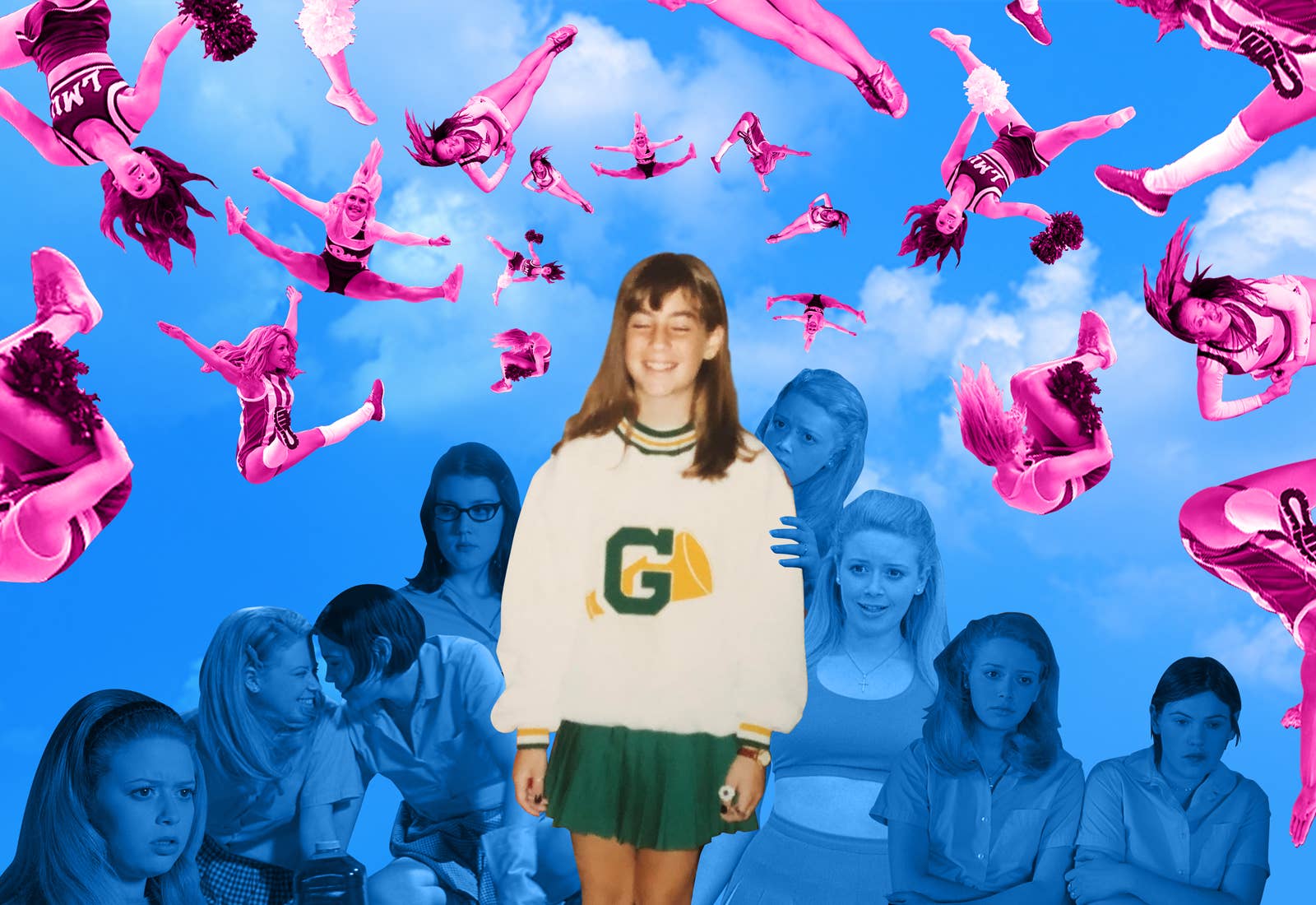
The thing I wanted most was a varsity uniform. The top was a snug green shell with a zipper up the back, with “Hornets” in sparkling gold block letters across the chest. There were grosgrain ribbons with your name on them, cut to hang perkily off your ponytail. There were hornet stickers for your temples and special-order Asics with matching green swooshes on the sides. But the centerpiece was the skirt, dark green with car wash pleats.
Let’s talk about pleats for a second. Skinny knife pleats are common on longer skirts, while the pleats on a Britney-style schoolgirl kilt are fatter. Our car wash pleats were medium-width, but they opened. Each pleat was a separate strip of fabric, as if our skirts had been shredded into fringe from the upper thigh down. The effect was a flash of movement when the squad kicked or jumped at the same time, our skirts flying in all directions away from our legs. Over and over again, the strips of fabric lifted and resettled against us as we moved through the hallways.
Our school had a well-enforced dress code: Wear shorts that didn’t reach the tips of your fingers and you’d get sent home. But our skirt pleats began just under our buttocks, which were covered in special green briefs, meant to excuse the fact that you could often see our underwear. I searched online for these skirts recently and came up short. They must have been a late-’90s trend. These days, cheerleaders wear far more modest paneled skirts with a little wedge cut out of the bottom, avoiding pleats entirely.

“I didn’t know you were a cheerleader, Tori,” my geometry teacher said on the first game day. I didn’t expect such a nerd to be on the squad, he might have said. I shivered with pleasure. I had maneuvered my way into high school royalty, and the uniform was proof.
It hadn’t come easy. Other girls sauntered onto the squad with no experience, just decent-enough rhythm and blond hair. But I’d known I would have to work for it. My jumps would have to be higher than everyone else’s, my motions cleaner, my smile bigger, because I had intuited years ago that something was wrong with me.
Nobody was a lesbian in my private Dallas high school. I didn’t know anyone gay except Ellen, who came out on TV the month before I finished eighth grade. I listened to Ani DiFranco and worshipped my best friend, but it did not occur to me that I might like girls.
It’s almost impossible to imagine now, like the teenagers who don’t understand rotary phones. But in my universe, queerness was only ever mentioned in whispered rumors or shouted insults, and even then, kids only said “faggot.” Nobody even called me a dyke, because those didn’t exist.
A cheerleading uniform would fix me, I decided.
On my all-white block in North Dallas, the moms stayed home. Across the street, the Smiths had too many kids to fit in a minivan. Everyone knew why my friends Jonna and Jenna down the block were so wild: Their mother worked. Pretty girls landed husbands who made enough money that their kids wouldn’t have to go to — gasp! — daycare. My own father sneered whenever we’d drive past a Kindercare; I have never seen him wash a dish.
I’d grown up gazing at an 8 ½ by 11 Dallas Cowboys cheerleaders poster that my dad had brought home for me: rows of Texas pinups with huge hair, tiny shorts, and smooth legs above white tasseled cowboy boots. The boots matched their white leather vests, which barely closed over blue blouses, tied right under their breasts. They were acceptable role models for your elementary-age daughter in the early ’90s; they helped our ’Boys win three Super Bowls that decade.
In sixth grade, when my friends and I wrote love letters to Jonathan Brandis (RIP), I cut out a photo of a blonde cheerleader named Tiffany from the high school yearbook and taped it to the notebook paper, hoping to catfish him into a reply. She was my best shot: Jonathan would have to write back to someone so beautiful.
I needed the help. I had a reputation at school for winning spelling bees, and I didn’t know who Kurt Cobain was until he died. I wore giant hoop earrings that I thought were sexy, but I didn’t know I was supposed to shave my legs until Austin Sleeper laughed at the knee hairs poking through my tights. I studied how my friends flirted with boys, but I never knew what to say to them. In algebra, whenever I’d ask a question, the boys in the back would chant my name to the tune of the Mortal Kombat theme song: “T-t-t-t-t-t-t-Tori, T-t-t-t-t-t-t-Tori.” I stopped raising my hand.
I was bad at girlhood, so if I wanted to be happy, I’d have to work very hard at it.
A cheerleading uniform would fix me, I decided. I made the ragtag middle school squad easily, because there were no cuts. There were only six of us, all seventh-graders, and people kept quitting. To my dismay, our uniform, unlike the varsity glamour I’d expected, was a T-shirt printed with a cartoon hornet and bright green skirts left over from the field hockey team. Basketball season was better; we got sweatshirts with a striped neckline and wrist cuffs, a megaphone appliqué in gaudy green and yellow on the chest. In a seventh-grade photo of me in that sweatshirt, I stand in front of the fireplace, my deep ’90s bangs shoved to the side while I tried to grow them out, cowlicking up at the edges. My eyes are closed but I am grinning, as if I can’t quite believe my luck.
I knew the high school squad would be tougher, so I enrolled in a gymnastics class. If I could do a back handspring on a hardwood floor, the tryout judges couldn’t say no to me. It was the equivalent of SAT tutoring — buy your way into a better technical score — but it came from a desperate belief that I could work harder than everyone else and win. Like the football team from Navarro College of Cheer fame, 73 miles away, our football players weren’t any good — but like the Navarro cheerleaders, I could try to be.
Some part of me must have known I was queer, which is why I mounted such an elaborate campaign to shield myself from the accusation. Or maybe it was simpler: I was bad at girlhood, so if I wanted to be happy, I’d have to work very hard at it.
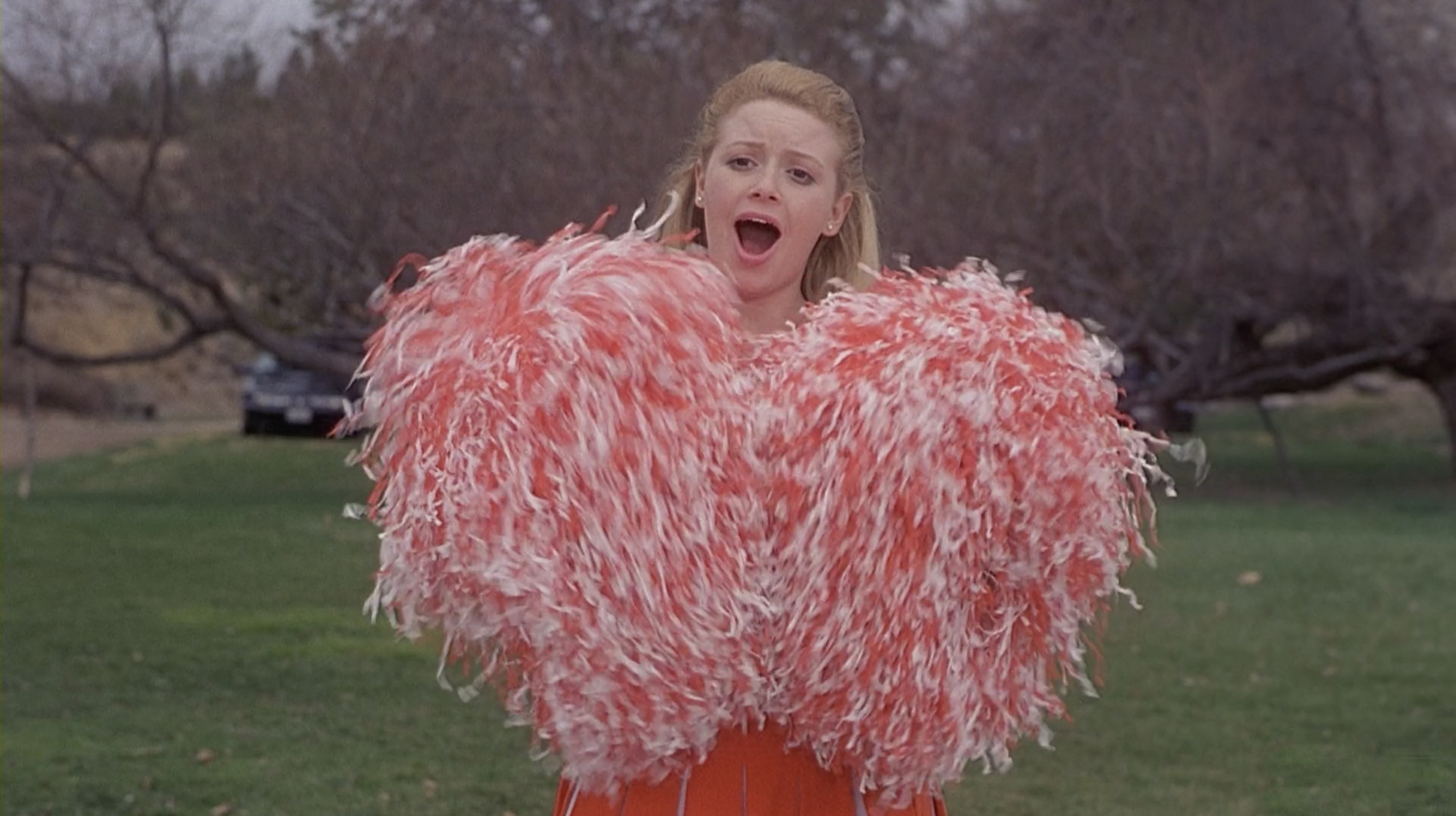
Twenty years ago, when Jamie Babbit’s cult gay film But I’m a Cheerleader was released, I’d never seen anything queer on the football sidelines. Eleven years later, in 2011, fictional cheerleader Santana Lopez came out on Glee. In 2019, Napoleon Jinnies and Quinton Peron, both out and gay, made their Super Bowl debut cheerleading for the LA Rams, to broad acclaim — though Jinnies said he endured years of anti-LGBTQ bullying before he got there.
Cheerleading still has a strong grip on the American imagination. Netflix’s docuseries Cheer, following the travails of an intense junior college cheerleading squad, turned its subjects into stars after it premiered earlier this year; Billie Eilish and Kathy Bates tried on cheerleader Jerry Harris’s championship ring at the 2020 Oscars. Harris, “the gay black icon we need in 2020” according to BET, and his teammate La’Darius Marshall, who went viral for his high-energy cheering even before the show, are the most charismatic of the group, but the vibe among all male cheerleaders on the mat is unabashedly gay. Coach Monica Aldama knows Corsicana, Texas, isn’t necessarily the most gay-affirming place, but she says she’ll “fight tooth and nail for them.”
The film’s inside joke of a title, one side of an implied dialogue, uses cheerleading as the ultimate heterosexual archetype.
Her girls, however, maintain the same rigid physical appearance that has always been expected of female cheerleaders. They spend hours on hair and makeup while the boys sleep in, diet despite extreme athletic demands (their coach survives mostly on protein drinks), and femme up for their thousands of Instagram followers. Though Lexi’s wears a “nonbinary” shirt in the first episode, which gave me hope for a second, it’s never again mentioned, and she and the other girls dutifully adhere to classic gender expectations. If any of them are queer, we wouldn’t know.
In the conversion therapy hot seat in 2000’s But I’m a Cheerleader, Natasha Lyonne’s character Megan protests that she coudn’t possibly be gay. “I get good grades. I go to church. I’m a cheerleader!” she insists. The film’s inside joke of a title, one side of an implied dialogue, uses cheerleading as the ultimate heterosexual archetype. It’s the perfect defense — or it was back then. Gay people knew better, of course; obviously, gay cheerleaders existed, just like gay football players and gay firefighters and gay drag queens existed. But most straight people didn’t know that, and most of us deep in the closet didn’t know it, either.
The tragedy of the “but I’m a cheerleader” defense is that it’s no defense at all — there are no sartorial escapes or professions that can ensure your heterosexuality. “Oh, honey, you’re in denial,” the gay chorus at conversion camp tells Megan, a dramatized version of the argument those of us in the closet had with ourselves.
“Oh, honey, you’re in denial,” the gay chorus at conversion camp tells Megan, a dramatized version of the argument those of us in the closet had with ourselves.
Cheerleading is a stand-in for femme, in Megan’s case. It’s her gender that precludes her homosexuality, she thinks, falling prey to the same assumptions that most Americans make: all gay men are nancies and all lesbians are butch. (Femme dykes, I should say, have existed throughout history, navigating the straight world invisibly or sometimes very loudly.) Megan’s parents aren’t convinced that her gender presentation means she’s straight, however; sensing her lack of attraction to her boyfriend, they send her to conversion therapy camp, where she and the other accused homosexuals learn how to be straight from counselor RuPaul.
Among the other kidnapped teenagers at conversion camp with Megan, there’s a broad range of genders: three late ’90s variations on riot grrrl (goth femme, bookish girl with glasses, and Clea DuVall’s Graham, a proto-Shane with greasy hair and a cigarette); Dante Basco, who played Rufio in Hook, is a beefy wrestler in a letter jacket; sissy boys abound. Director Jamie Babbit implies solidarity across the queer gender spectrum: Whether femme or butch, they’re all fucked, and they can only rely on each other.
The film was released in the US in July 2000, just before my senior year of high school, and the reviews were terrible. But even though straight critics hated it, But I’m a Cheerleader quickly became a queer cult classic; in 2018, Autostraddle named it its top movie of all time. DuVall tweeted recently that she was “very closeted” when she made the film, which eventually helped her come out, and hundreds of people responded with weepy emojis and stories of watching it whenever they needed to feel seen. At a time when directors constantly killed off lesbian characters – which still happens today — the film’s rare happy ending showed both DuVall and legions of fans that queer romance was possible. Made for $1.2 million in 2000, it earned $2.6 million — unlike Bring It On, made for $10 million and released the same year, which brought in $90.5 million and spawned multiple sequels, making it the biggest cheerleading movie ever made.
Bring It On is also wildly homophobic. Despite its PG-13 rating — a stark contrast to But I’m a Cheerleader’s original NC-17 rating for references to girls masturbating — the white characters casually toss around “fag” and “dyke” in a way that feels jarring now, as do the male cheerleaders’ jokes about sexually assaulting the girls during lifts. Of course cheerleaders are the cruelest gender police, but the film’s enduring popularity and five (!) sequels suggest we should root for them anyway.
But I’m a Cheerleader rejects that premise, arguing that queer desire itself isn’t the problem, nor are femininity and masculinity — it’s the enforcement of gender roles and the accompanying anti-queer prejudice that make us all miserable.
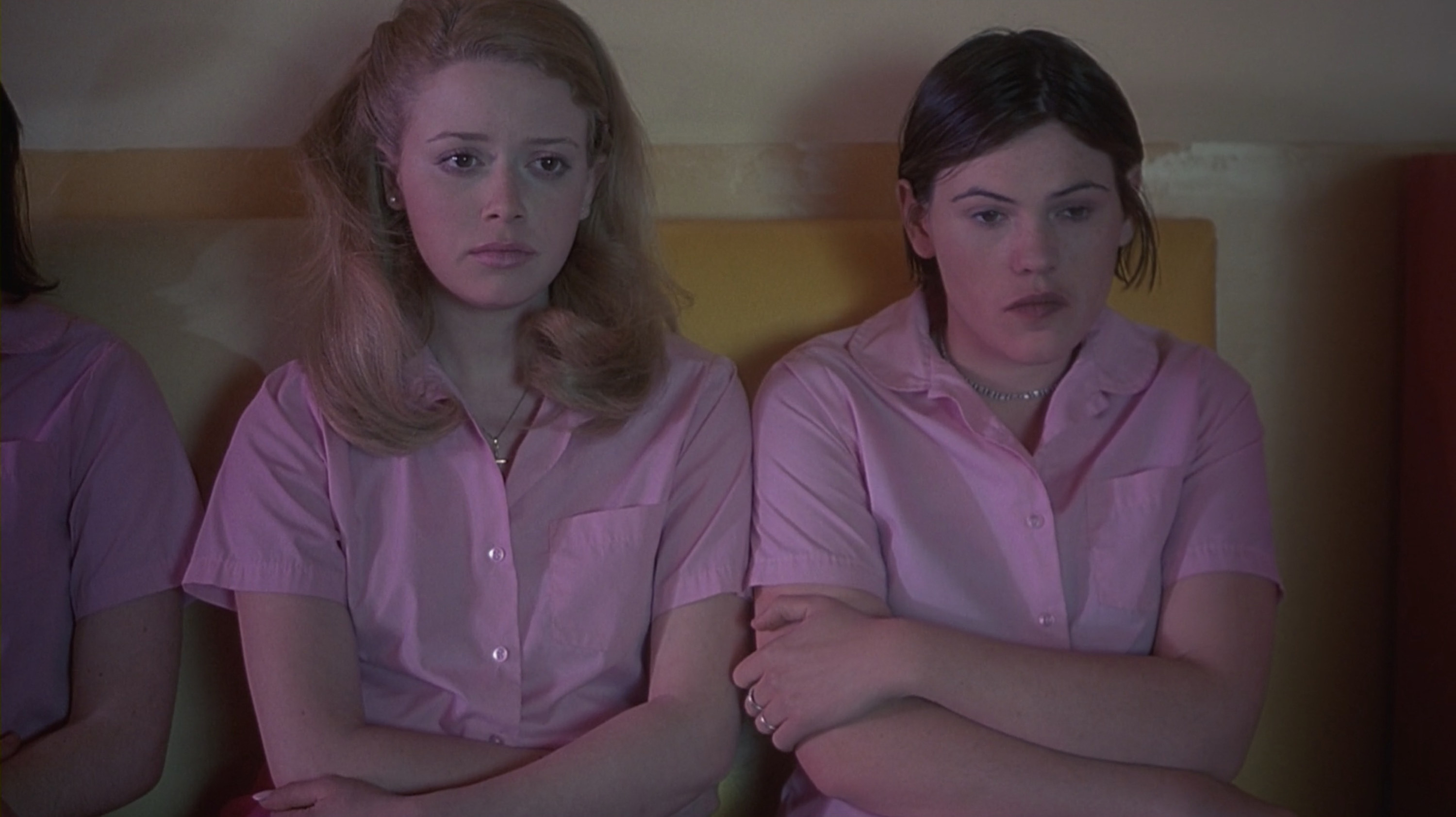
I made varsity and learned to use a tampon in the same week, at the end of ninth grade. The whole summer stretched out before me. By the time school started again, I’d be transformed by the uniform.
Our cocaptains were both named Rachel. The previous captain had been named Rachel too, but she’d left school because her dad got caught selling bad mortgages. This year’s Rachels were smart and pretty and not quite mean. I was terrified of them.
First up was cheerleading camp at Southern Methodist University. Squads poured in from all over North Texas to the place where Lawrence Herkimer pioneered the “Herkie” jump — one leg straight, one leg bent, with as much airtime as you could muster — that I’d spent years learning.
The morning camp started, a Rachel yelled at me right away. We’d met for pre-practice on someone’s front lawn, when the sun was still low enough that we could dance without sweating.
“You ruined our color scheme,” Rachel said. I was wearing a stretched-out gray sports bra under my white tank top, the first clean one I could find. Everyone else’s was black, so mine stood out when we turned around. I was mortified, like I’d already failed the first class.
Director Jamie Babbit implies solidarity across the queer gender spectrum: Whether femme or butch, they’re all fucked, and they can only rely on each other.
Everything at camp was a competition: how loudly you cheered in the cafeteria, your enthusiasm during aerobics warm-ups, your adherence to the dress-up theme on ’80s day. The Permian Basin squad, in oil country black-and-gold uniforms, performed with military precision, Navarro College–style.
On the first night, in the scramble to primp before our official performance, everyone crowded around the mirrors in our dorm rooms, heating hot roller sets and opening giant eyeshadow palettes. All I had was lip gloss, and there was no YouTube to learn from, so I put on my uniform, tied on my ribbon, and waited.
“Should I put on more makeup?” I asked a Rachel.
“No, you don’t need it,” she said without pausing, her eyes fixed on her face in the mirror. It was a compliment, so I didn’t understand why it felt like an insult.
On the last night, we passed around pillowcases to sign, yearbook-style. “I’m so excited to cheer with you!” I wrote dutifully to girls I’d never spoken to at school but had admired in the hallway. I’m so excited to be you, I could have written. I got my pillowcase back and read the messages, scanning through them for something real or personal. My eyes landed on what Staci had written: “Dear Tori, blah blah blah blah blah blah blah. Love, Staci.” She hadn’t even bothered to lie.
I should have known. In eighth grade, the phone would ring at 11 p.m. on a Friday, jolting me out of sleep. My parents had finally installed another line, my new bedroom cordless with my own number, and I couldn’t let them hear it late at night or else they’d take it away. When I picked up on the first ring, the caller had disguised their voice into a high-pitched squawk.
“You suck at cheerleading! You suck!”
“Who is this?” I’d ask, over and over, while the people on the other end dissolved into laughter. They’d call back again five minutes later. I didn’t know how to turn the ringer off, so I’d wait, tensed up, for the next call, speculating about who it could be. It could have been Andy or Austin or Staci’s boyfriend. It could have been a Rachel-in-training. They never revealed themselves, calling every few weeks, enough to fill me with dread whenever the phone woke me up. I didn’t tell any of my friends. Maybe I did suck at cheerleading, or maybe everyone could just tell I was a fraud.
My ambition must have been obvious. It made me an easy target: Call this girl and make fun of her for the thing she wants most in the world. If I’d been less desperate, no one would have noticed. But I was an impostor, and we all knew it.
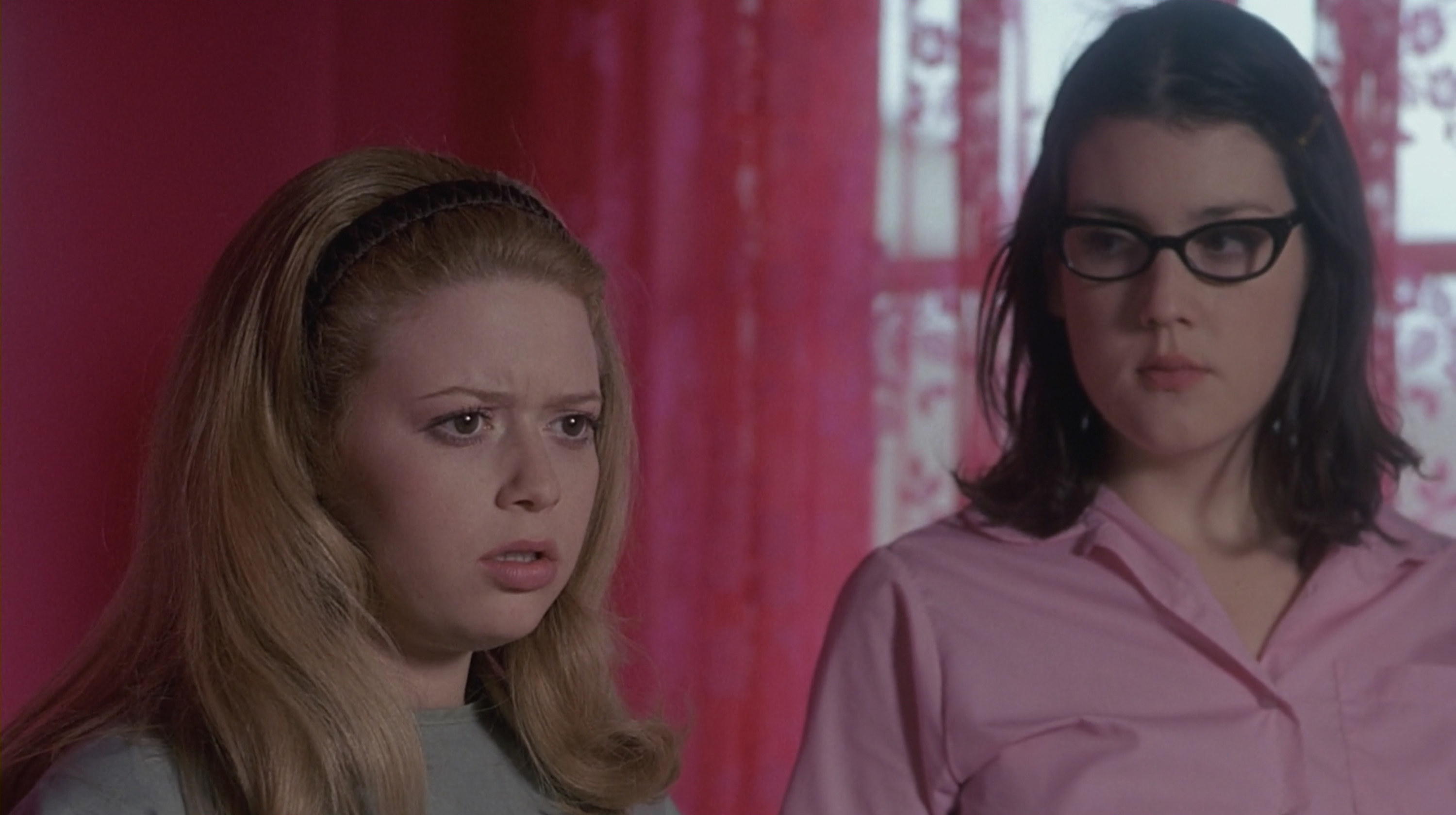
I don’t remember what I did at the football dinners. Every Thursday night, the players’ mothers and the cheerleaders would serve spaghetti and garlic bread to the whole team. Carbohydrates and ego stroking would make the boys feel good, which would help them win the next night. The wife training was implied, as was our talent for it; the dinners were one reason girls joined the squad in the first place, a protected space outside of school to flirt with current and future boyfriends. The cheers were hard, but this was the easy part, at least for everyone else. I never knew what to say, not to the captain or the nice backup quarterback or the linebacker who always sat against the lockers with his legs out for you to trip over.
Did I wander around, trying to find a quiet guy on his own to sit next to? Did I keep eating brownies so I didn’t have to talk much? Did I check on the meat sauce in its chafing dish or wipe up spills from salad dressing bottles? All I remember is dread beforehand, panic during dinner, and shame afterward.
The night before homecoming was the busiest of the year. We had hours of practice for the next day’s pep rally, then the plan was to pile into cars around 10 p.m. to drive around visiting every senior football player’s house to toilet-paper the yard. We’d sleep for a few hours, then get up early to shoe-polish cars in the parking lot at school. (“Happy Homecoming ’98!”)
The toilet paper was an open secret. They knew we were coming, but we’d pretend to be stealth, parking next door and sneaking out of the car. Like the dinners, it was another excuse for cheerleader–football player contact, a tradition built for straight kids to pair off.
It was the part of the day you were supposed to look forward to. A Rachel blasted the Dixie Chicks from her Land Rover, and I sang along to “Wide Open Spaces” from the back seat. It was dark already, and the big Texas sky still felt vast and liberating from the highway.
The armor I had tried to put on — the car wash skirt and shell top, the hours of practice in the mirror — wasn’t enough.
But at the first house, I struggled to feign excitement. Surprising a football player was fun if you were actually friends with them — or if you’d dated the quarterback. The senior would always open the front door in gym shorts and we’d pretend to be upset at getting caught. I concentrated on throwing the toilet paper as high as I could.
As midnight approached, I started to drift off. “You need to be perkier,” a Rachel had told me weeks before on the sidelines as I watched the football clock start and stop for endless timeouts, wishing it toward zero. It was hard enough to fake perky when I was awake.
By the last house, I couldn’t make myself get out of the car. The other girls slammed the doors and I curled up on the back seat alone, the leather cold under my skin. I could hear them laughing outside, barely bothering to whisper as they aimed for the branches.
I had been trying so hard, and it was exhausting. The armor I had tried to put on — the car wash skirt and shell top, the hours of practice in the mirror — wasn’t enough, and I couldn’t imagine keeping the effort up the rest of the year. There was something wrong with me for real.
What I didn’t understand at the time was that all of us were working hard. I thought the Rachels knew how to embody Texan femininity because they had something I didn’t. But they’d just learned how to adapt early — plus, they were straight. They hid their labor better, ducks paddling furiously under the water.
These days, the Rachels are married with children, and that labor likely includes barre class and eyelash extensions and remembering birthdays and all the housework, unless you are rich enough to pay someone else to do it. “Natural” femininity is a scam. Beyoncé, the hardest-working Virgo in show business, already knows that. For trans women, the stakes are even higher, as trans journalist Katelyn Burns writes: “It is a never-ending balancing act, getting the ‘right’ combination of feminine and masculine in our appearance to align with society's impossibly narrow criteria in a way that offers us safety in passing as our true genders.” In Disclosure, a new Netflix documentary about trans representation in Hollywood, Laverne Cox describes using makeup as war paint to prevent people from misgendering her: “I was so viciously harassed on the streets of New York early in my transition, and I would arm myself.”
Maintaining a pretense of perfect femininity requires self-denial, hours of time, and endless shopping. But back then, I didn’t realize there was no endpoint, that the work was forever — even after you make varsity or get a boyfriend — and that we were all in training to make that lifelong job look seamless.
When I left the squad a month later, I dropped out hard. I swapped the skirt for Old Navy cargo pants and wore Birkenstocks without realizing they were a lesbian standby. I stopped wearing makeup, then stopped talking to friends who did, deeming myself above such a vapid interest. My new friends were the only ones who seemed available: a 16-year-old version of your Republican dad, a quiet future doctor, and a few truly annoying kids. At the only post-prom party I got invited to junior year, 20 of us silently watched Monty Python on someone’s living room floor, their parents in the next room. I was lonely, but the only way I could live with my failure was to think of it as a choice.
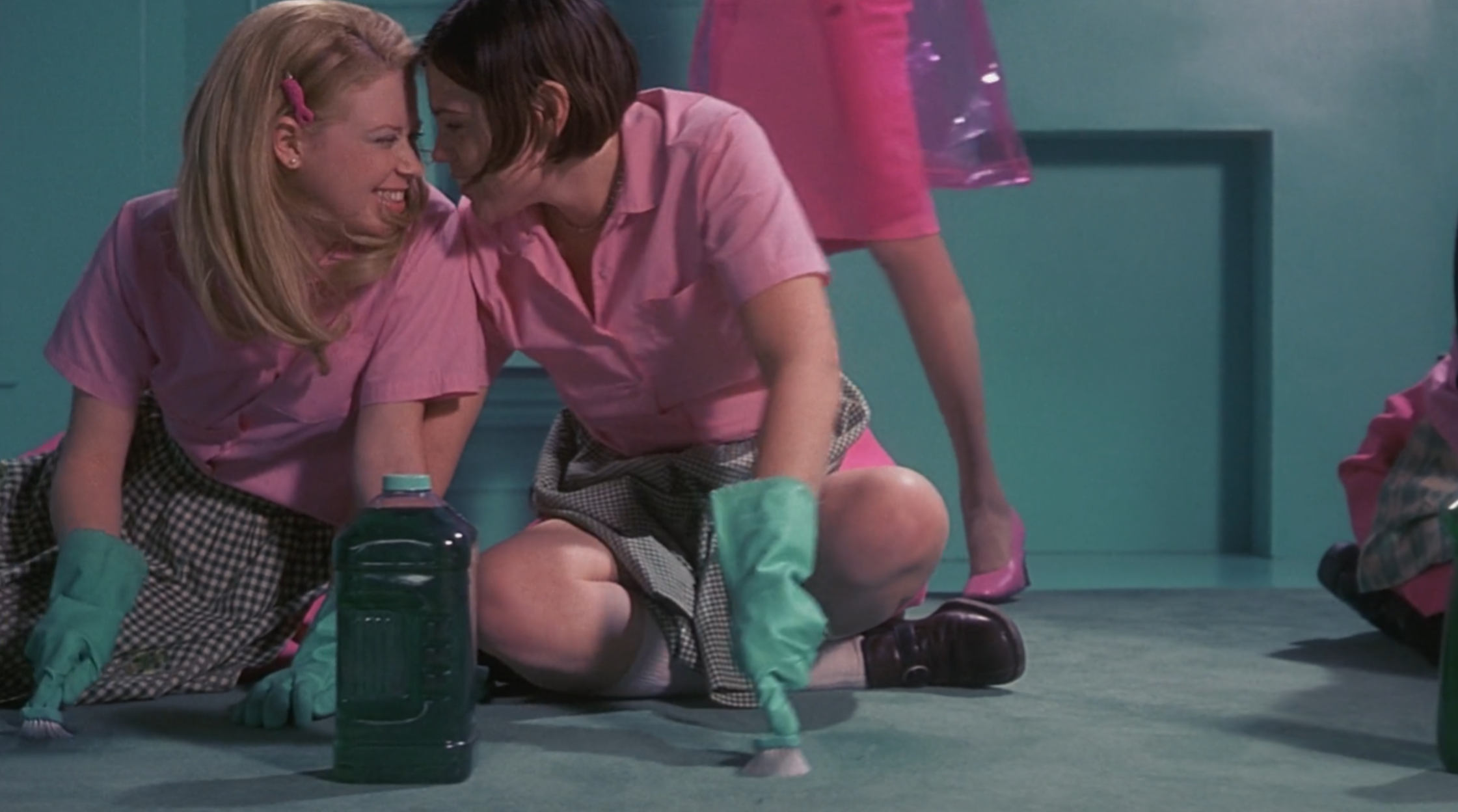
It would have been easy for But I’m a Cheerleader to make fun of Megan’s femininity — her matching sweater sets, her pearl earrings, and her commitment to all of it even in a hellish setting. (Why do you care so much about stupid girly things, you stupid girl?) But the film is triumphantly pro-femme. Never does it hate on Megan’s perfect hair or her pompoms. In preserving Megan’s gender all the way through the film, she makes sure we know it’s not the problem. The problem is the requirement that women be feminine and men be masculine — and the belief that women exist to serve men.
Lyonne, whom you now know for her show-carrying New York wit, pulls off an earnest innocence that makes the film a campy romantic comedy rather than dark John Waters–style raunch. In a gorgeous femme moment that my Gen Z friends would call “so pure,” Megan appears in her orange sports bra and cheerleading skirt in a last-ditch attempt to rescue Graham from conversion therapy. “One, two, three, four! You’re the one that I adore!” she cheers, and it works. Graham hops in a car and runs away with her, finally brave enough to live a gay-ass life together, like Thelma and Louise without the cliff at the end.
As Megan’s self-awareness blooms, But I’m a Cheerleader gives us a model of femininity that’s legitimate despite men, not because of them.
Initially, in Megan’s mind, it’s impossible that anyone with her gender identity could be gay, because she thinks femininity always involves guys who can affirm its success. As Megan’s self-awareness blooms, But I’m a Cheerleader gives us a model of femininity that’s legitimate despite men, not because of them. That model is starting to resonate more two decades later. There is no girl-meets-boy love story in Hustlers, for example, where the strippers wear chinchilla for themselves, not to impress the men they scam. Female moviegoers showed up in droves, and male critics sputtered.
Babbit, to her credit, knew that gender and sexuality are two different things, and she didn’t assign higher value to any one gender expression. “Everybody thinks I’m a big dyke because I wear baggy pants and play softball and I’m not as pretty as other girls,” says Jan, the butchest character among the “girls” at conversion therapy. “But that doesn’t make me gay.” She leaves camp in a huff. In contrast, Megan’s femininity wasn’t sufficiently focused on men, so she had to go to camp to get “fixed.” I wanted cheerleading to make me better at being feminine and therefore better at being straight. I wish I’d known that neither of us needed fixing.
When I came out to my dad at 21, in the kitchen on Thanksgiving weekend, he asked, “Is it because no men are available?” He could not conceive of a world where I would date women if men were an option, so he assumed I was not pretty or charming enough to pick up guys. In his mind, my gender failure had led to a strange choice of sexuality, where I’d finally been able to win on the loser playground. (“I’ve had bad sex with plenty of men,” though accurate, seemed like the wrong thing to say.)
Fortunately, we have pride parades for that level of shame, and they worked on me. I went to my first one in a cargo skirt, an unconsciously femme version of the pants I thought were my only lesbian fashion option. You were either straight and feminine or gay and masculine, and I wasn’t a Rachel, so I hid beer bottles in my giant pockets and forgot about cheerleading.
But nothing fit me like that uniform. There had been times when it felt good, usually on Friday nights on the sideline, when the football players were facing the other direction. All I had to do was let my car wash pleats fly and seduce the crowd.
Gender was a thing I could learn and make my own, not a list of rules I had to follow.
I chased that feeling for years, the click when my body and my outfit and my energy and my sexuality aligned. The longer I lived in New York, encountering millions of varieties of gender every day, I began to speculate that femme might be the thing that, for me, would tie them all together. One night getting high in a friend’s Bed-Stuy apartment, a queer femme named Leah wandered upstairs from her basement bedroom. She worked in a feminist sex shop, and I liked how she carried herself. I asked if she’d show me what to do with eyeliner before I went out, and she was gracious enough to bring me to her big mirror downstairs. We barely knew each other — she was just my friend’s roommate — but she showed me what to do, sharpening her black eye pencil so we could share it. It was an act of generosity that I hadn’t associated with femininity before and that I am grateful for still. Gender was a thing I could learn and make my own, not a list of rules I had to follow.
The final image of Megan and her trusty pompoms, cheering earnestly for Graham, is powerful because we know she’s expressing herself authentically. She looks the same as in the first scene in her sports bra and skirt, but she’s been through hell and come back out, and the femme part of her isn’t going anywhere. It’s an image I carry with me whenever I need my own cheerleader. ●
